
In February 1943, while Staghound production was still under way, British officials raised the issue of an anti-aircraft variant. British armored-car units in the Western Desert had come under frequent Luftwaffe attack and now mobile air-defense capability was sought. The obvious solution was to use the British-designed Frazier–Nash twin .50cal machine-gun turret, which was already being manufactured in the United States by the Norge Division of the Borg-Warner Corporation, as the N80 turret for British motor torpedo-boats. This had to be adapted to an armored-vehicle configuration including a turret race, turret basket, and armored turret. The turret was too small to accommodate the vehicle radio, so this was stowed in the hull in place of the bow machine-gun. The T17E2 pilot was shipped to Aberdeen Proving Ground for firing tests in March 1943 and returned to Chevrolet for modification and final development work. Improvements included a General Electric power-booster ammunition feed and an improved gunsight. The turret was redesigned, using welded construction and curved plates for a more efficient layout. The crew of the vehicle was reduced from five to three due to the limited space in the turret. A total of 2,610 rounds of ammunition were stowed. British representatives were happy enough with the design that the existing production contracts were modified so that instead of the 3,800 T17E1 armored cars planned under the schedule of September 1, 1942, a total of 1,000 units would be diverted to the T17E2. The first production vehicle was completed in September 1943 and in December sent to Fort Knox for troop tests and to the Antiaircraft Artillery Board at Camp Davis, North Carolina, for firing trials. Some modest modifications were made during the production run based on these tests. Production was completed in April 1944. In the end, however, this proved to be the least successful version of the Staghound as by the time it arrived in Italy and North-West Europe in the summer of 1944, the Luftwaffe threat had largely evaporated.

Scale plan of interior.
In the autumn of 1943, British army officers in Washington forwarded a request to Ordnance for the design of a fire-support version of the Staghound for dealing with roadblocks and other tactical obstructions too formidable for the Staghound’s small 37mm gun. Since the requirement was for only 100 vehicles, the project did not warrant the development or expense of a new turret. Ordnance had already developed a 75mm howitzer turret for the M5 light tank that had been accepted for service as the M8 75mm howitzer motor carriage in May 1942 and was already in production. This was readily adaptable to the Staghound hull, and Chevrolet quickly constructed the T17E3 pilot in October 1943; this was sent to the Erie Proving Ground in December 1943. However, British interest in the requirement waned and the project ended by late December 1943, even though it was not officially cancelled until late 1944.
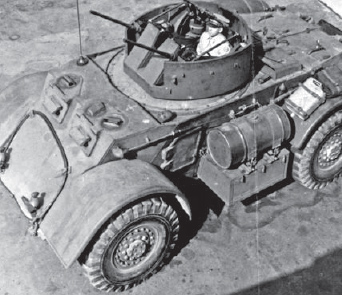
The T17E2 represented an effort to develop an anti-aircraft version of the Staghound armored car with a twin .50cal heavy machine-gun turret. Although 1,000 were built, they were the least successful version of the type as there was little need for air defense against the Luftwaffe in the final year of the war. (NARA)
Even though the T17E3 project never proceeded beyond the pilot, the requirement still existed. As detailed below, the New Zealand Divisional Cavalry Regiment in Italy had developed a field modification by substituting 3in Mk I howitzers for the usual 37mm gun. These conversions, undertaken in Italy and variously referred to as the “Staghound 3in” or “Staghound II”. A more elaborate fire-support variant was proposed in Britain in the autumn of 1943 using surplus Crusader Mk III tank turrets. A new turret ring was adapted to the Staghound and the Staghound turret basket was modified to fit the Crusader turret, which was re-armed with a more powerful Mk V 75mm gun and a co-axial Besa machine-gun. A Staghound III pilot was put together in December 1943 and eventually sent for trials at the Fighting Vehicle Proving Establishment at Farnborough. However, the trial results were not entirely satisfactory. To begin with, the Crusader turret accommodated only two crew instead of the three in the normal Staghound turret, so the commander had to double as the loader. This created a tactical disadvantage since the commander, distracted by these duties, could not observe the fall of shot when the gun fired to provide any necessary corrections. The tests dragged on until January 19, 1945, and the requirement was trimmed from the original 100 vehicles down to 50. In the end, only 32 vehicles were converted by war’s end and the first three were sent to the Canadian XII Manitoba Dragoons in Germany. The Canadians concluded that the Staghound III was “probably the best all-round 75mm armoured car available” but the type’s significance proved to be negligible due to its late arrival.
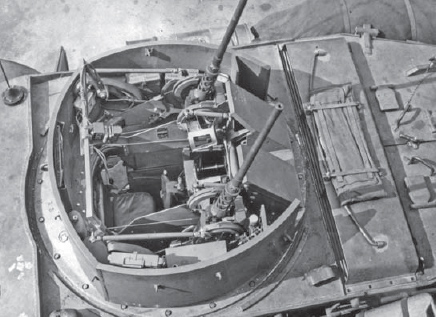
The T17E2 Staghound AA substituted an armored Norge N80 twin .50cal heavy machine gun turret for the usual 37mm gun turret. In this overhead view, the guns are at full elevation but pointed towards the rear of the vehicle. (NARA)
US MEDIUM AND HEAVY ARMORED CAR PRODUCTION
| 1942 | M5 (T17) | M6 (T17E1) | M6 (T17E2) | M7 (T18E2) |
| Oct | 28 | |||
| Nov | 8 | 54 | ||
| Dec | 24 | 75 | 2 | |
| 1943 | ||||
| Jan | 66 | 100 | 1 | |
| Feb | 68 | |||
| Mar | 124 | 312 | 9 | |
| Apr | 26 | 275 | 7 | |
| May | 2 | 256 | 11 | |
| Jun | 322 | |||
| Jul | 279 | |||
| Aug | 335 | |||
| Sep | 228 | |||
| Oct | 198 | 12 | ||
| Nov | 147 | 71 | ||
| Dec | 167 | 128 | ||
| 1944 | ||||
| Jan | 220 | |||
| Feb | 200 | |||
| Mar | 225 | |||
| Apr | 144 | |||
| Total | 250 | 2,844 | 1,000 | 30 |
| B | STAGHOUND MK III, 11 TROOP, C SQUADRON, 12TH MANITOBA DRAGOONS, II CANADIAN CORPS, GERMANY, 1945 |
| The rebuilt Staghound Mk III was refinished in SCC 15 Olive Drab, a color adopted by the British army in April 1944 to avoid the need to repaint the many US vehicles received via Lend-Lease. The British color was essentially similar to US olive drab. As the corps reconnaissance unit, the arm-of-service insignia is the usual green/blue square with a white band above. The corps insignia is seen on the left side. The squadron insignia is a white circle on black background on the glacis plate and rear turret side; inside is the troop number and vehicle number. A movement marking is chalked on the right fender. The vehicle census number F116572 is painted on the glacis plate under the squadron marking. |

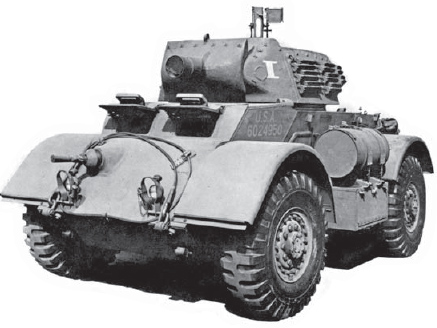
The T17E3 combined the turret from the M8 75mm howitzer motor carriage with the T17E1 hull to provide a fire support version. However, it never entered production beyond this pilot. (NARA)
A variety of requirements were established for specialist Staghound variants, primarily oriented towards command issues. A command version that was mooted would have had the gun removed and map and filing desks added inside the turret. Although two of these were nominally authorized under war establishment for each armored-car regiment, few if any of these conversions were formally undertaken. Instead, many commanders used normal Staghounds fitted with a second radio in the hull. However, some senior commanders preferred more spacious alternatives. One conversion in North-West Europe was the Staghound Charger, sometimes carried out using surplus Staghound AA cars. These had the turrets removed and a plastic windshield fitted at the front of the opening. This gave the regimental commander more room and better visibility. A second authorized command type was designated “Staghound control”, with four assigned to each armored-car regiment. These headquarters vehicles had a second No 19 radio set added along with a stowage box on the outside of the turret; the main gun was retained. The Canadians built their own equivalent, the “Staghound Rear-Link”. On this version the 37mm gun was deleted but a long-range CR-299 radio and associated antennae were added. As the designation implies, this vehicle served as a communications link between the armored-car regiment and corps or other headquarters to the rear.
US MEDIUM AND HEAVY ARMORED CAR CONTRACTS AND REGISTRATION NUMBERS
| Type | Vehicles | Contractor | Registration numbers | Serial numbers |
| M5 (T17) | 250 | Ford | 6025150–6025399 | 2005–2254 |
| M6 (T17E1) | 1,500 | Chevrolet | 6022838–6024337 | 5–1504 |
| 1,000 | Chevrolet | 6030712–6031711 | 4275–5264 | |
| 300 | Chevrolet | 6024838–6025137 | 5767–6018 | |
| 44 | Chevrolet | 6090205–6090248 | 6065–6108 | |
| M6 (T17E2) | 500 | Chevrolet | 6024338–6024837 | 1505–2004 |
| 500 | Chevrolet | 60119997–60120496 | 6109–6608 | |
| M7 (T18E2) | 30 | Yellow | 6030412–6030441 | 3–32 |
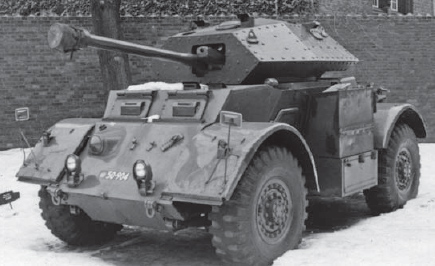
The eventual solution for up-arming the Staghound was the Mk III, which substituted a surplus Crusader tank turret and 75mm gun. Only 32 of these were converted and a handful were deployed with the Canadian XII Manitoba Dragoons in April 1945. Eight were supplied to the Danish army in the late 1940s and one is seen here, preserved at the army museum in Copenhagen in the 1960s. (Col R. J. Icks)
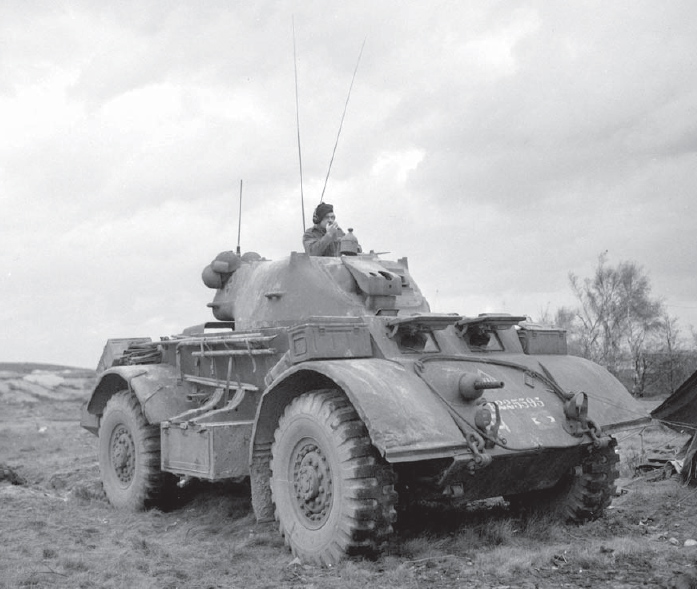
The Canadian army operated Staghound Rear-Link, a headquarters version that had the gun removed in order to accommodate a larger CR-299 radio set to communicate between regiment and corps headquarters. This example was serving with XII Manitoba Dragoons near Zeedam, Netherlands, on April 4, 1945. (NAC Ken Bell PA130920)
| C | STAGHOUND MK I CROSS-SECTION |
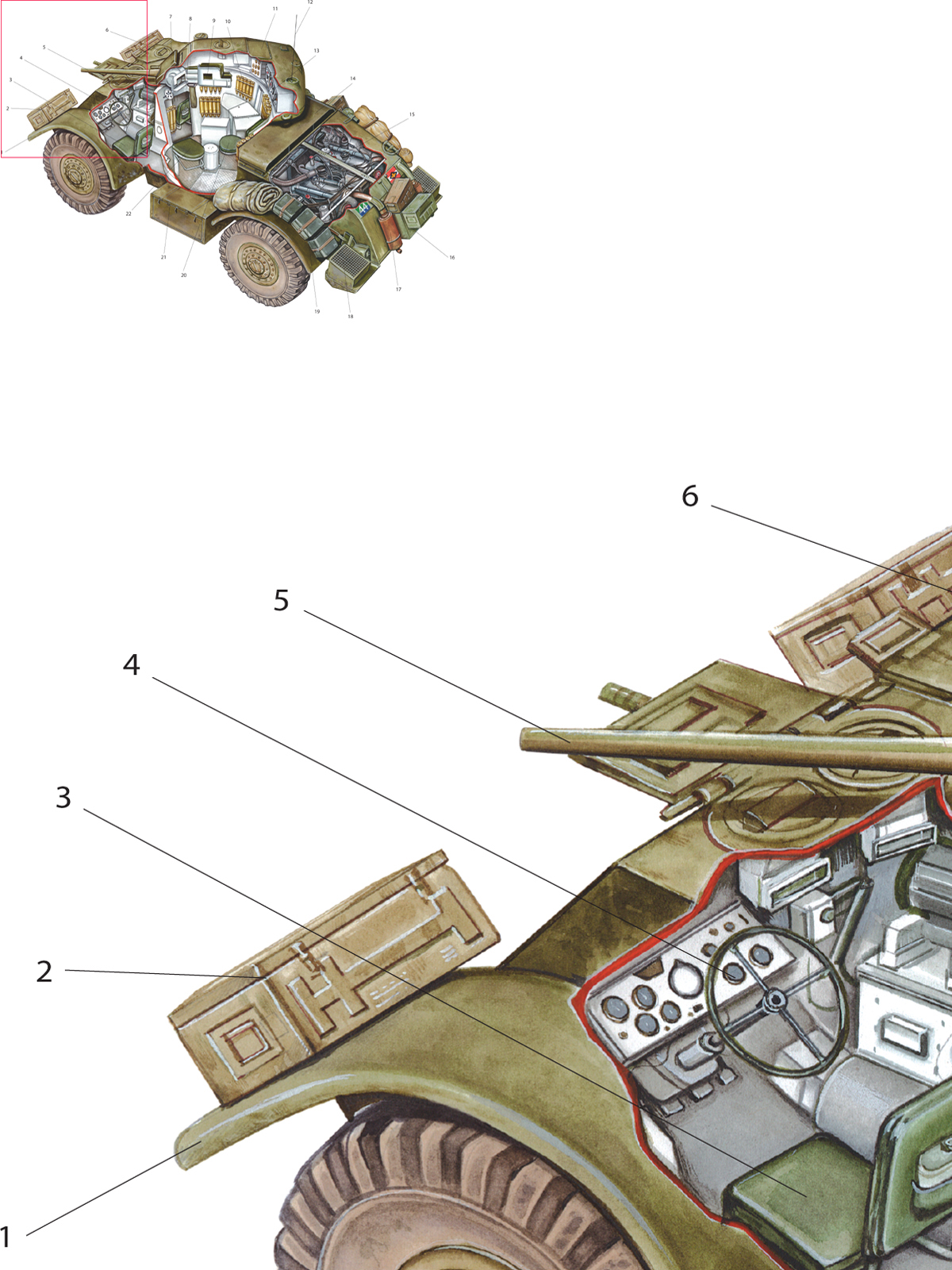
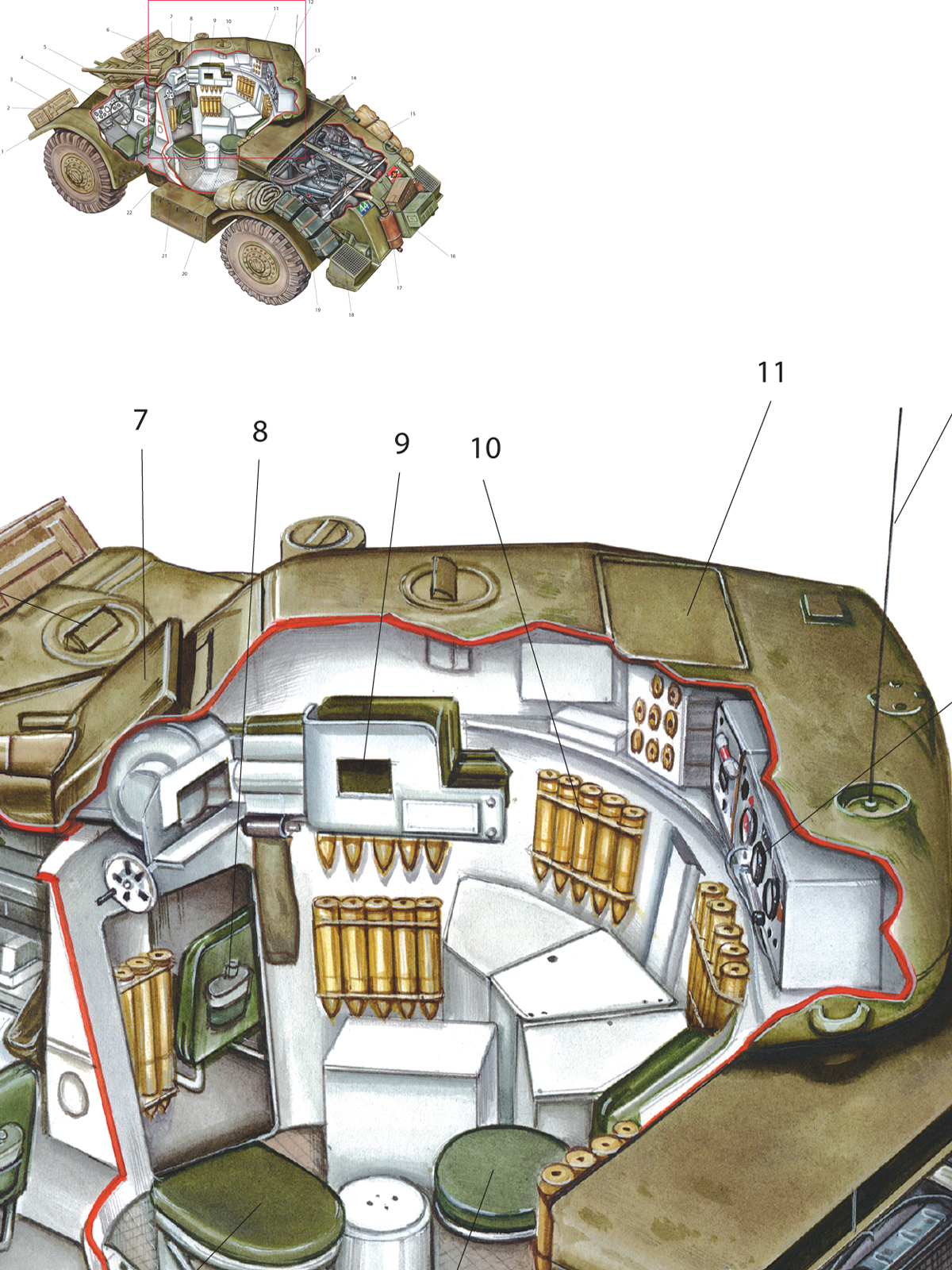


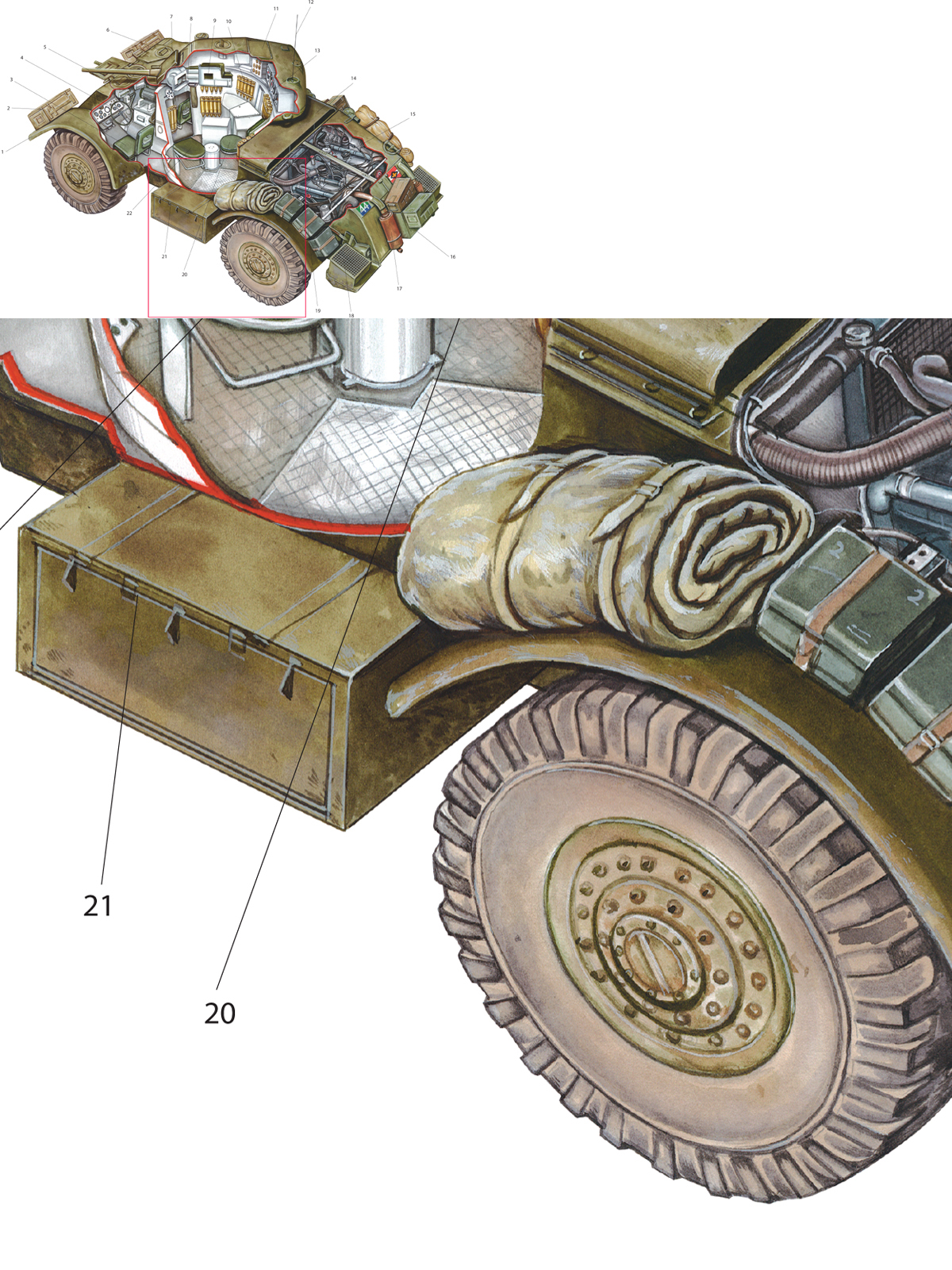
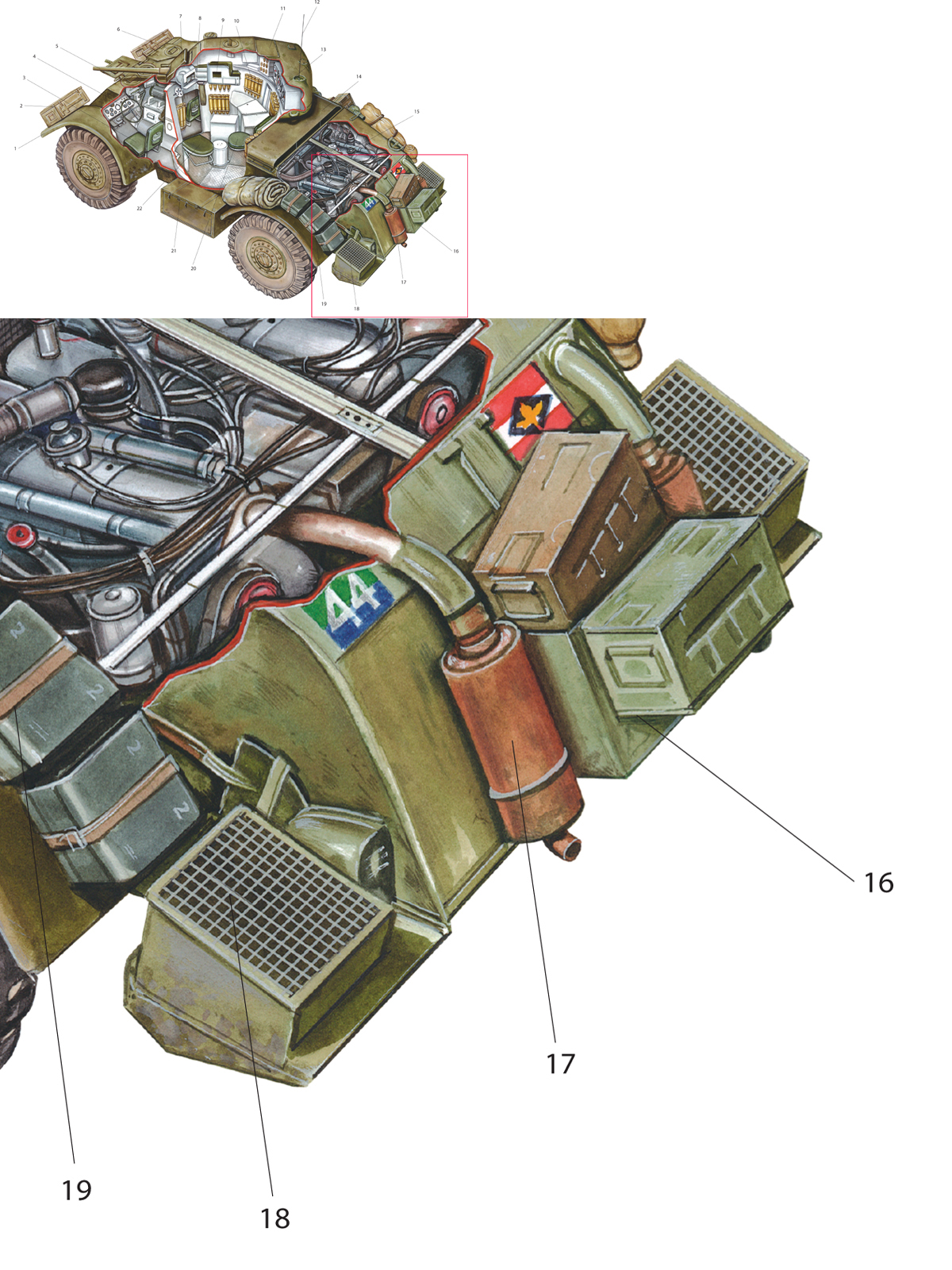
KEY
1 Front left mudguard
2 Added stowage bin from steel ammunition box
3 Driver’s station
4 Driver’s controls and instruments
5 37mm M6 gun
6 bow gunner’s periscopic sight
7 37mm gun mantlet
8 Bow gunner’s seat
9 37mm M6 gun breech and protective shield
10 37mm ammunition stowage
11 Loader’s hatch
12 Radio aerial
13 No 19 radio set
14 Armored cover over radiator air intake
15 Twin GMC engines
16 Rear stowage bin
17 Exhaust muffler
18 Deep wading trunk’s lower stub
19 Ration boxes attached for stowage
20 Commander’s seat
21 Side stowage bin
22 Gunner’s seat
TECHNICAL DATA
Crew: Five (commander, gunner, loader, driver, bow gunner)
Length: 216in
Width: 106in
Height: 112in
Ground clearance: 15in
Weight: 27,220lb (30,705lb combat-loaded)
Power-to-weight ratio: 12.6hp/ton
Armor: 22mm upper bow, 19mm hull side, 25mm turret front, 32mm turret side
Armament: Main: 37mm M6 gun in M24A1 mount (103 rounds); auxiliary: three .30cal machine-guns (co-axial, front hull, turret AA mount; 5,250 rounds)
Powerplant: Two GMC 270 6cyl, 97hp (194hp total)
Fuel: 62gal internal plus two 38gal external tanks
Transmission: Hydramatic 4F 1R
Wheels: Four 14.00 x 20 21-ply combat tires
Steering: Hydraulic power-assisted steering on front pair of wheels
Radio: British No 19 set
Maximum road speed: 55mph
Maximum trench clearance: 1.5ft
Maximum vertical wall clearance: 21in
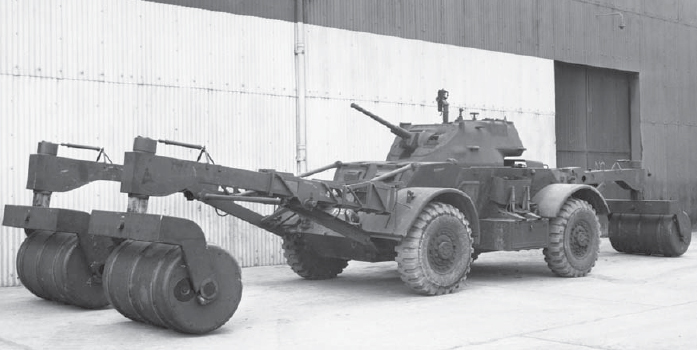
One of the more awkward contraptions fitted to the Staghound was the Bantu mine-detection system, which used a set of magnetic detectors contained in wooden drums. (IWM MH 14033)
There was also some interest in fielding an engineer version of the Staghound to counter the threat of German anti-tank mines. A prototype was constructed in the spring of 1944 using the Bantu mine detector. This elaborate contraption contained detector coils within wooden drums that were pushed in front of the Staghound. A corresponding device, the AMRCR (anti-mine reconnaissance caster roller), was a mine-rolling system designed to detonate anti-tank mines sufficiently far in front of the Staghound to prevent damage from the blast. However, both systems proved too cumbersome for actual field conditions and in neither case did development proceed beyond trials.